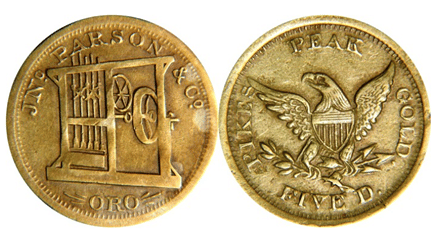
Learn About John Parsons and Company Colorado Gold Minting
Gold was discovered not only in California and in Oregon. Colorado had its turn in the sun as well. In 1850, gold was discovered in Park County which is about 150 miles southeast of Denver. Miners came in droves to the towns of Tarryall and Hamilton and the populations of both towns swelled.
Dr. John Parsons was one of those people who came to seek his fortune. But Parsons came, not to pan or dig for gold. His intention was to set up a minting facility so he ordered coining equipment and had several sets of dies created.
By the end of June 1861, Parsons & Co. were preparing to strike gold coins. However, there was no permanent location for his business. It is believed that his “mint’ was located in the back of a wagon. Both $2.50 and $5.00 gold coins were struck by him. But this experiment was short-lived as they only struck coins until October.
The $2.50 gold coins had a depiction of a minting machine. Above the machine were the words “J. PARSONS & Co.” and below was the Spanish word for gold “ORO.” The reverse had a crude depiction of a federal eagle with a shield body, complete with arrows and a branch in the talons. Around the periphery was “PIKE’S PEAK GOLD” and the denomination “2 ½ D.”

No one knows exactly how many gold coins J. Parsons & Company actually struck and given that his Mint was in the back of a wagon, the number must have been fairly small.
Parsons also struck a $5.00 Gold Coin which was significantly larger than the $2.50 but with the same exact design, except that the denomination was changed from “2 ½ D.” to “FIVE D.”

During October of 1861, Parsons likely struck less than $500 face value of coins as the “Phillips Lode” from which most of the gold he minted into coins had come, had now run dry.
Although the coins were well-received and eagerly awaited by bankers and merchants in Colorado, they were not assayed so the fact that parsons made approximately 20% on each coin was overlooked. It is also likely that Parsons designed the coins himself, which attributes to the carelessness of spelling.
The word “Oro” on the coins was thought to be Spanish for gold, but there is a town called Oro City, where Parsons had planned to locate.
Only a combined 11-14 specimens of both denominations are known making all of Parsons’s surviving gold coinage truly rare, which is reflected in their value. Coins infrequently come to market and usually when they do, they draw great interest and strong bids at major coin auctions across the country.
| Date | Type | Mintage | VF Value | XF Value |
| (1861) | $2.50 | 6-8 Known | $300,000 | $450,000 |
| (1861) | $5.00 | 5-6 Known | $475,000 | $650,000 |
Expand your collection today and shop our assortment of Pre-1933 U.S. Gold Coins.




